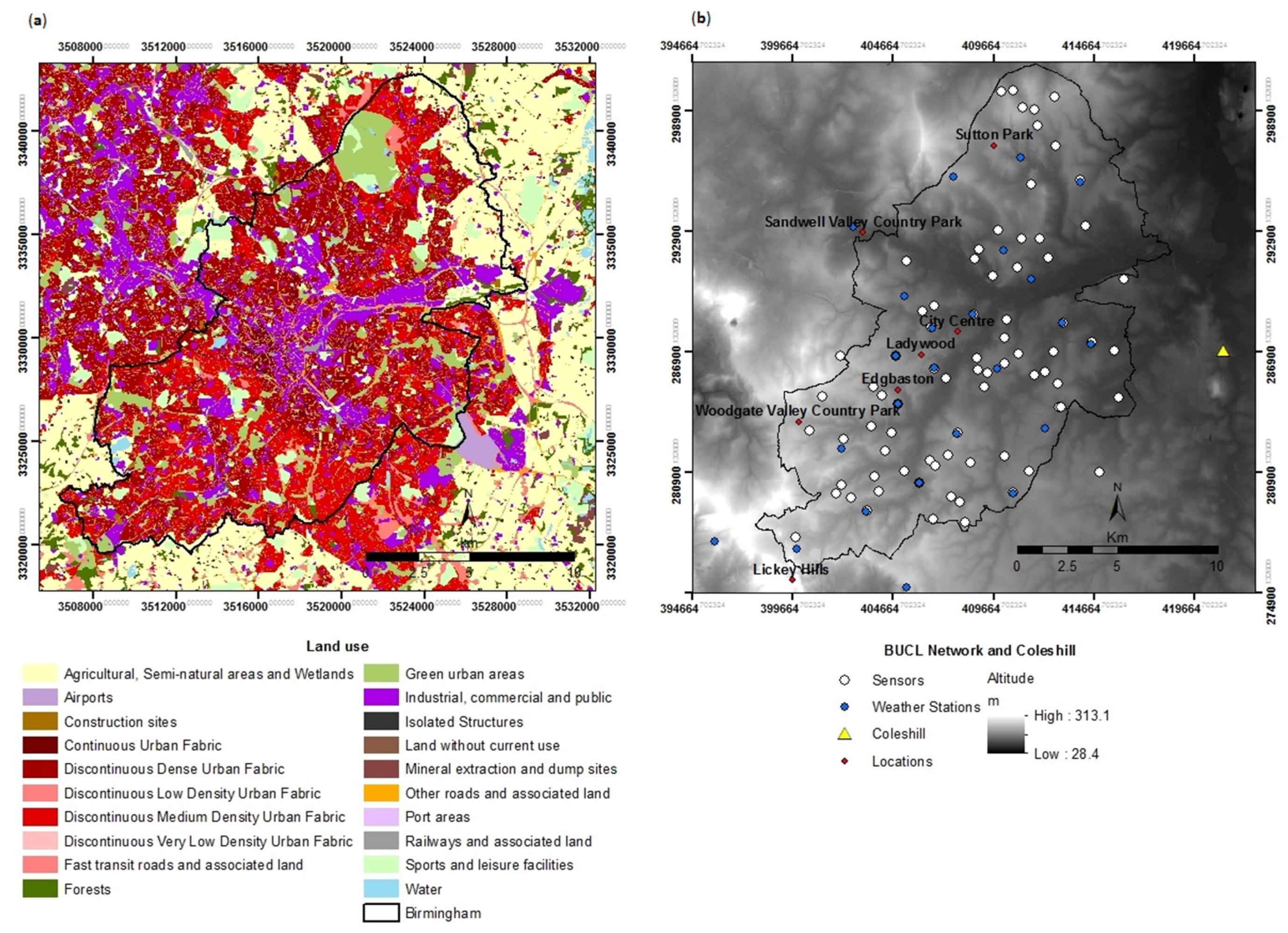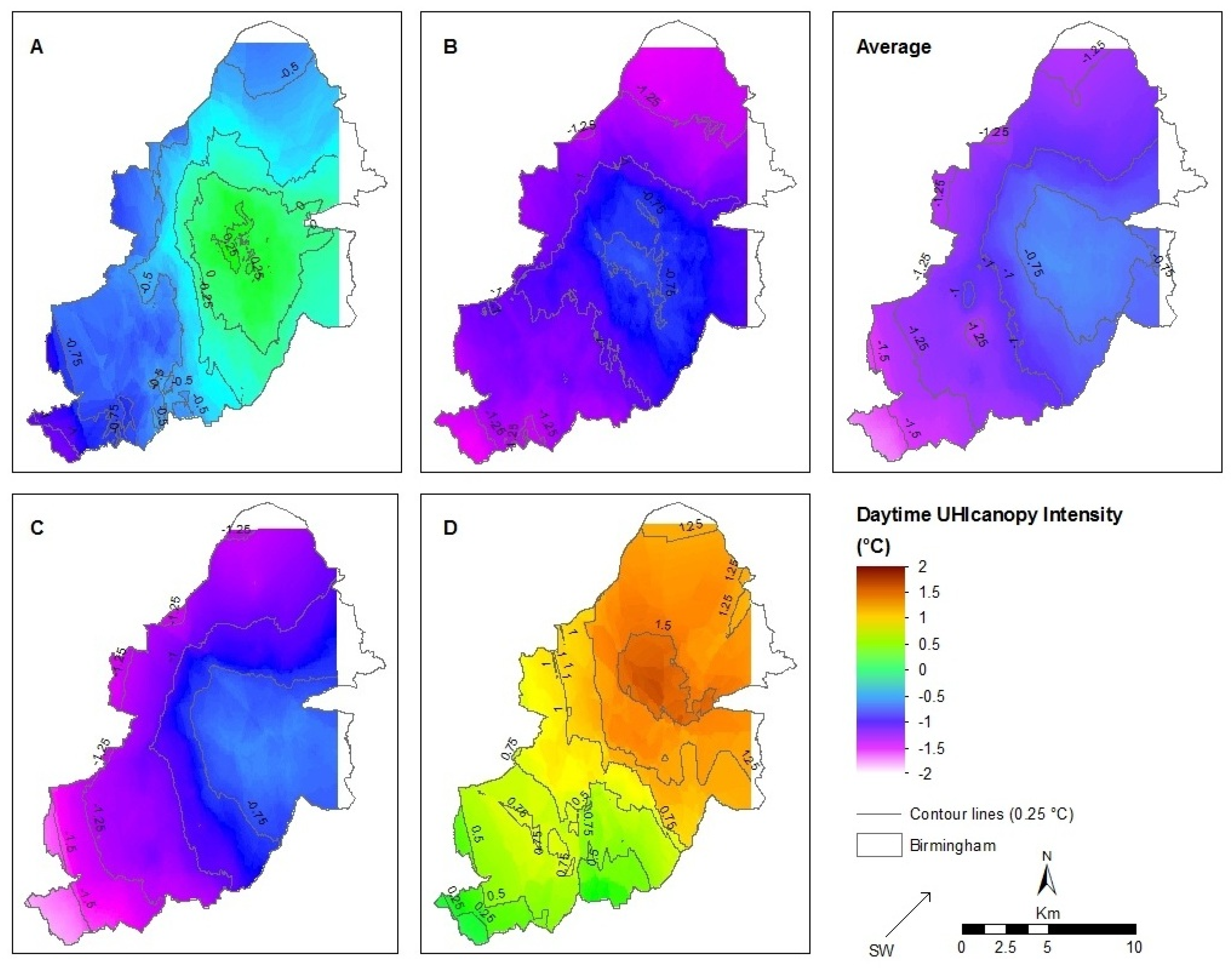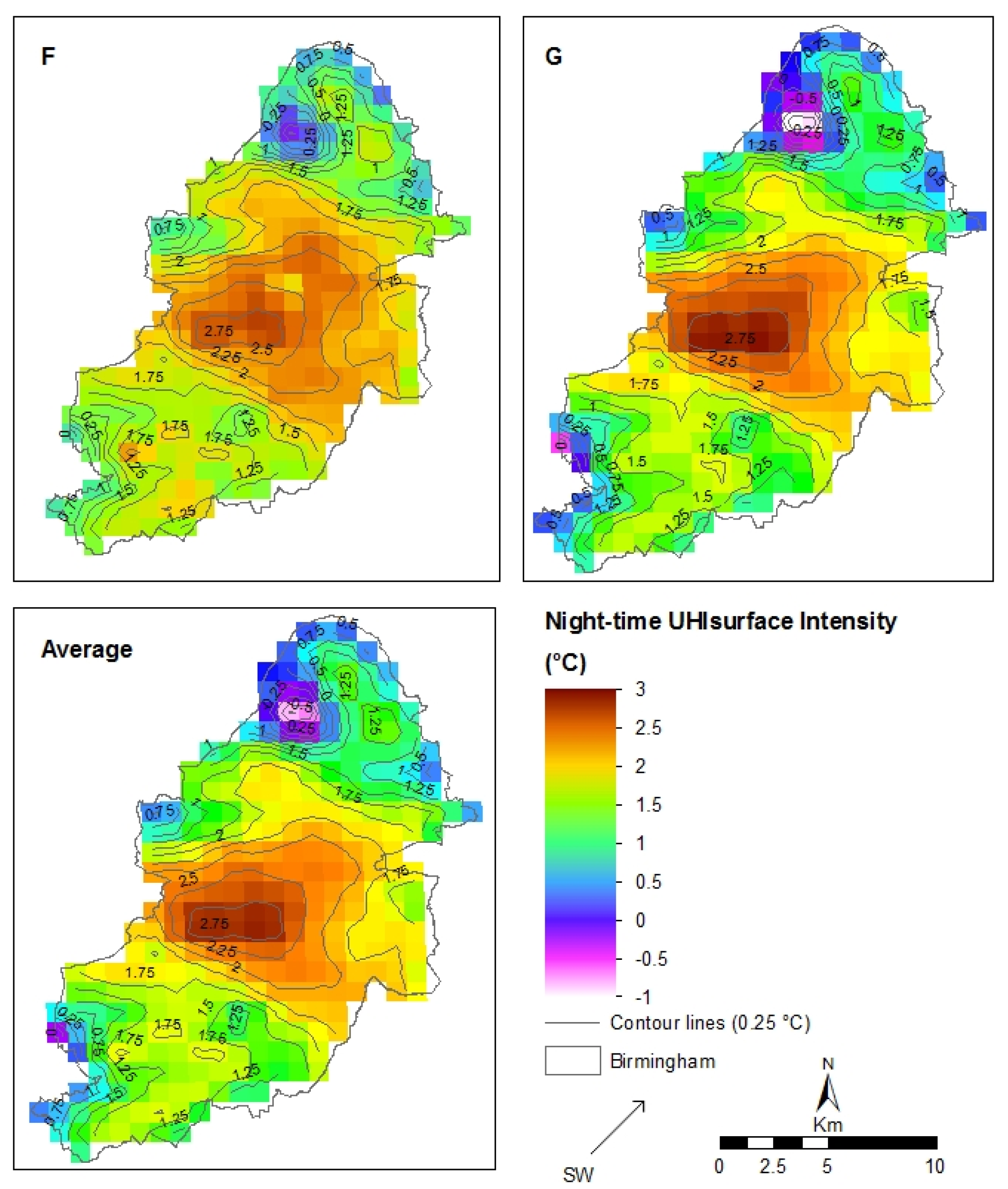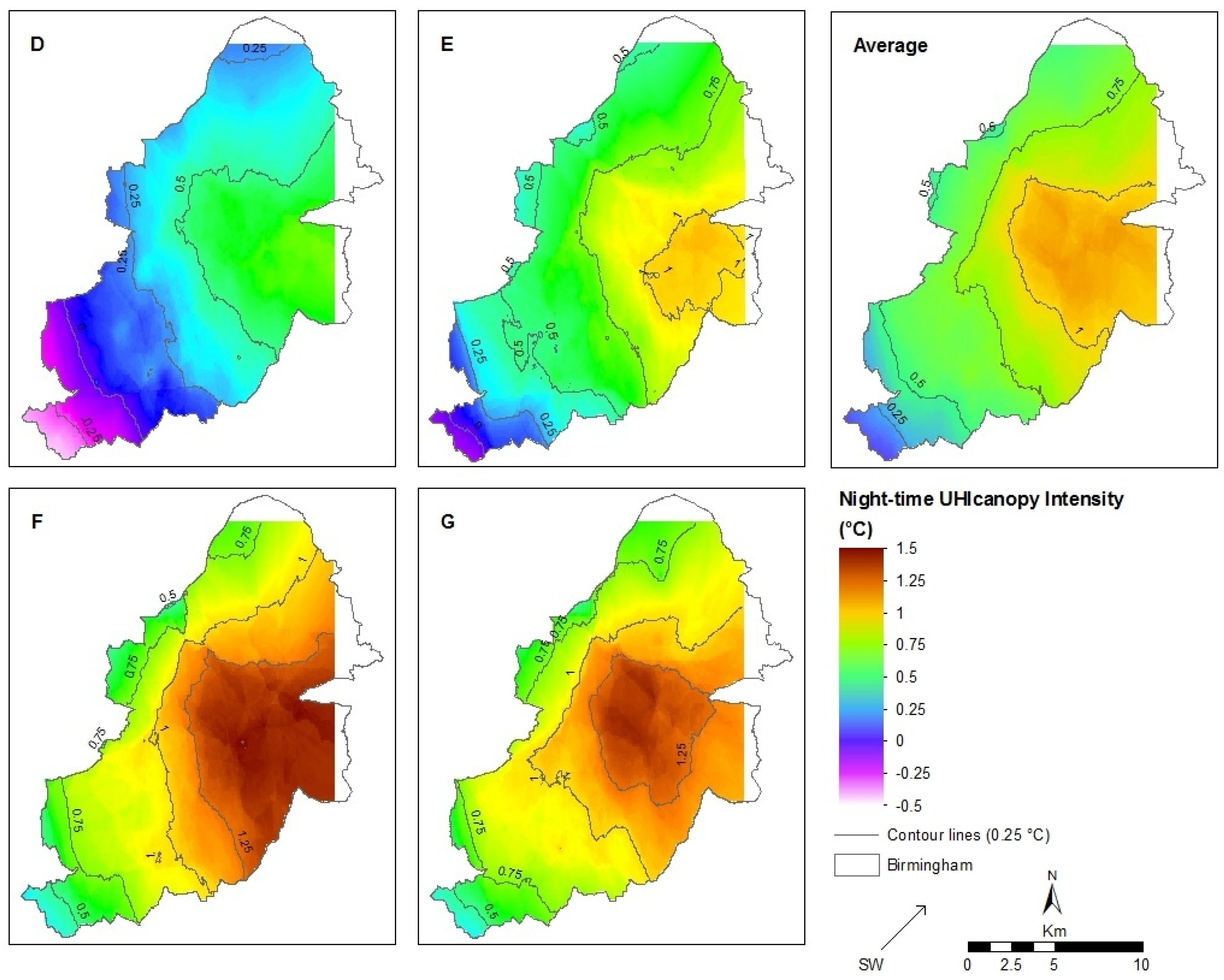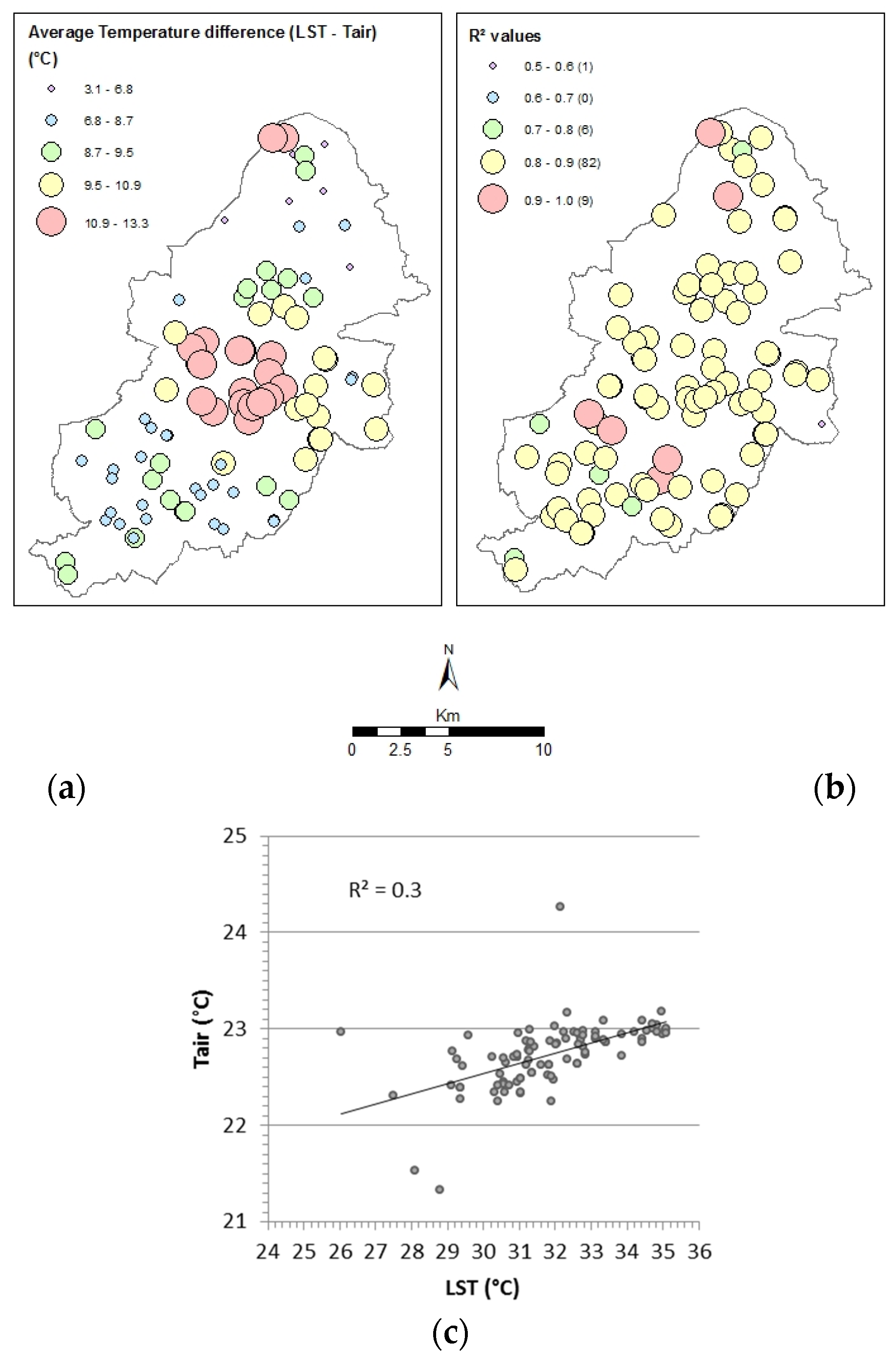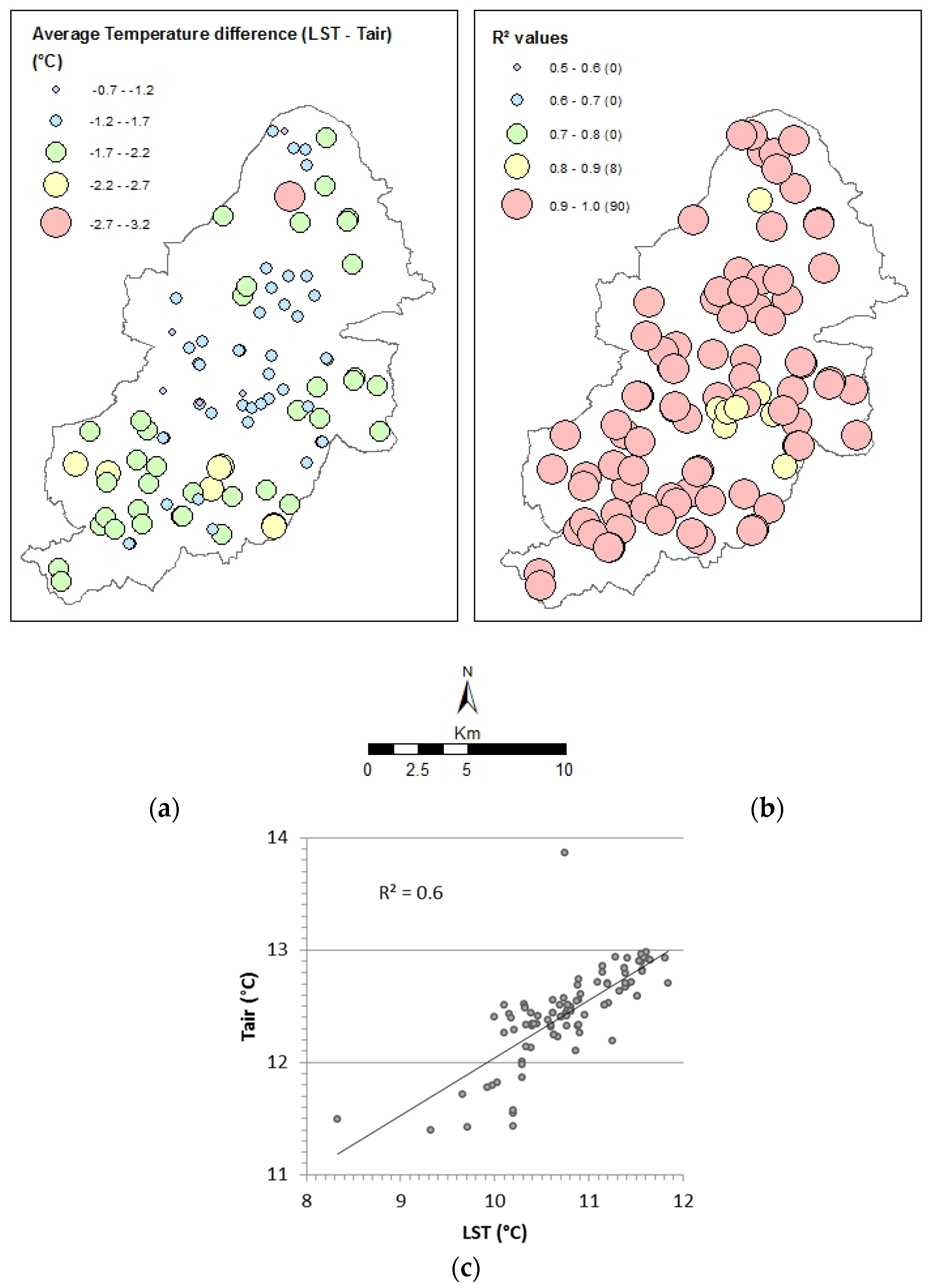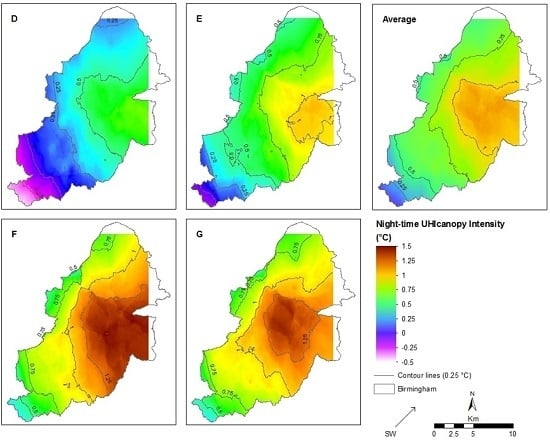1.1. Background
The Urban Heat Island (UHI) continues to be a widely researched phenomenon concerning the difference in temperature between an urban area and the rural surroundings of a conurbation. A range of factors contribute to the occurrence of the UHI; increased emissions of anthropogenic heat flux, changes to urban geometry and the replacement of vegetation cover by construction material (e.g., asphalt and concrete)—all of which directly change surface albedo, emissivity and evapotranspiration [
1]. The result is that it is common to find urban–rural temperature differences in excess of 5–10 °C under “ideal” conditions (e.g., clear skies and light winds). In many cases, the UHI is strongest at night; for example, a study a Paris showed that the magnitude of the night-time UHI was up to 7 °C more than the daytime UHI [
2]. However, the daytime UHI is still a significant phenomenon, but is far more complicated to characterise. For example, it was found that urban temperatures tend to be slightly warmer than rural ones during the daytime in London with morning urban and rural temperatures being similar, but scenarios also exist where urban temperatures can be cooler than surrounding rural areas [
3]. Systematic reviews of the UHI literature are available in [
4,
5] and both document a range of studies that have investigated both nocturnal and daytime temperature differences.
The UHI can impact many aspects of everyday life, such as critical infrastructure [
6], health [
7] and energy consumption [
8], with impacts becoming exacerbated under heatwave events. For example, a study of the 2003 heat wave in Paris indicates that, at night-time, a surface temperature increase of ~0.5 °C could double the risk of elderly mortality [
9]. Such events provide an indication of the increased impacts of the UHI in the increasingly warming climate projected to be experienced over the next few decades. Furthermore, the ever-increasing number of people in urban areas will not only further contribute to the exacerbation of the UHI effect, but will also increase the number of people exposed to its potential risks [
10].
Studies into the UHI can be largely subdivided into three different types: the surface UHI (UHI
surface), the canopy UHI (UHI
canopy) and the boundary layer UHI (UHI
boundary) [
4,
11]. The urban canopy is the thin layer of the atmosphere between ground level and roof top height and is strongly influenced by urban geometry and microscale energy exchange. The layer is just beneath the urban boundary layer [
11] located above roof level and whose characteristics are affected by both mesoscale processes (
i.e., prevailing wind) and the microscale processes below [
1]. Air temperature (T
air) is the key parameter to measure for UHI
canopy and UHI
boundary whereas land surface temperature (LST: often derived from satellites) is the parameter reported for UHI
surface. LST modulates the air temperature of lower layers, impacting on energy exchanges between the surface and air and therefore influences thermal comfort in the canopy layer as well as the internal climate of buildings [
12].
1.2. Measuring the Urban Heat Island
Traditional ways in which UHI
canopy are measured include station pairs (e.g., [
13]) or the use of transects (e.g., [
10]). Given the paucity of traditional T
air observations, and their limited spatial resolution [
10,
14], there has been an ongoing challenge to quantify the intensity and spatial extent of the UHI
canopy. A compromise is nearly always needed, whether it be temporal (
i.e., the transect approach) or spatial (
i.e., the station pair approach). Techniques for measuring the UHI
boundary are even more limited and rely on the use of tethered balloons, radiosondes or ground based remote sensing techniques [
15].
It is for these reasons that numerical modelling techniques have proven to be so popular in urban climatology [
16]. A range of models can be applied to estimate temperature variations in an urban area, such as the Weather Research and Forecasting model (WRF) [
17], Joint UK Land Environment Simulator (JULES) [
18], and the Met Office Reading Urban Surface Exchange Scheme (MORUSES) [
3]. WRF is a mesoscale numerical weather prediction model, with incorporated urban schemes and used operationally for forecasting and research. JULES and MORUSES are land surface models that effectively provides information of land conditions (e.g., surface energy balance), which is subsequently passed on to atmospheric models, such as the Met Office Unified Model. Although modelling has brought tremendous advances in our understanding of urban atmospheric processes, models need observation data for initialisation and verification meaning that a wider number of urban measurements, other than data from one or two weather stations, would help to evaluate models’ output.
To this end, there has been a recent increase in interest in the deployment of high resolution Urban Meteorological Networks (UMNs) [
19], driven by advances in technology, communications and the ever-increasing miniaturisation of low cost electronics [
14]. Such networks enable atmospheric processes to be observed at both high temporal and spatial resolutions, which is especially important when considering the heterogeneous nature of urban areas [
20]. Variables monitored by UMNs can include wind speed and direction, humidity, T
air and others. These data can be incorporated into microclimate models that can be further integrated into planning tools and other industrial applications to inform policy and decision-making. However, despite the advantages, the logistics of operating high resolution networks means that the number of fully working UMNs across the world is limited [
14]. However, new approaches (e.g., crowdsourcing [
21]) may help to improve this over time.
There are numerous studies in the literature that have quantified the UHI
surface using remote sensing techniques [
9,
10,
22,
23,
24,
25,
26,
27,
28,
29]. The key advantages being that regardless of the scale of study, remote sensing provides a consistent, repeatable and relatively cheap methodology for the end-user [
7]. Although the initial cost of remote sensing platforms remains high, the data availability and temporal and spatial coverage available of LST measurements and other co-located variables (e.g., cloud, vegetation, surface emissivity) are important for UHI
surface measurements and spatial risk mapping [
7,
9,
29].
Despite the advantages, there are complexities in the retrieval of urban LST including satellite viewing geometry, atmospheric attenuation of IR radiation, urban surface emissivity and sub-pixel variations of land cover and heat balance. As a result, thermal remote sensing studies in urban areas had been slow on developing results beyond qualitative descriptions of thermal patterns and simple correlations between LST and T
air [
12]. However, over the last decade, satellite derived LST were progressively integrated into climate models [
30,
31] and used to retrieve T
air [
32]. To this end, the increasing availability of UMNs, of unprecedented resolution, have an important role to play. High resolution T
air datasets are not only providing new information on UHI
canopy but also provide an opportunity to further evaluate the relationship between T
air and LST using datasets of comparable spatial resolution. Furthermore, given the paucity of UMNs, this relationship is potentially useful allowing LST to be used in a wider range of applications that presently depend on T
air measurements (e.g., seasonal estimation of energy use [
33] and electricity transformer ageing [
34]). To begin to meet this need, this study uses a high resolution UMN (the Birmingham Urban Climate Laboratory: BUCL), to quantify and compare the spatial pattern of the daytime and night-time UHI in Birmingham-UK, under a range of stability classes, for both UHI
surface and UHI
canopy.
